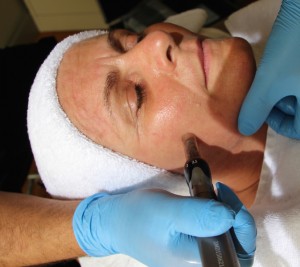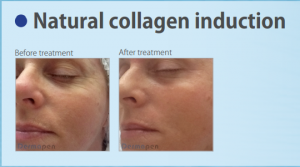
Skin Needling Special: Free Skin Assessment Plus 50% Off Your First Skin Needling Treatment. New Clients Only – Limited Time Offer!
Does Skin Needling Work?
There are hundreds of treatments nowadays; from Botox to fillers to even harvesting your own blood to spread on your skin. Clever marketing and packaging make even the most toxic ingredients and invasive procedures sound easy and desirable to the unsuspecting.
I know what you’re going to say “most celebrities have botox and they’re fine!” – well no, not always. What you don’t hear is the disaster stories about these toxic chemicals.
The majority of these products are made from synthetic foreign materials to act as “fillers” in aid of filling the gaps. The problem is, the moment you inject any foreign material, your immune system launches an immediate attack. Your immune system’s main function is to preserve life by protecting you from any foreign invasion be it a virus, bacteria or synthetic agent, it makes no distinction.
If it doesn’t contain your DNA, it’s on your immune system’s kill list and will keep attacking until it is completely destroyed. You may think what an inconvenience, but without the single-mindedness of our immune system, we would not last a week in a bacterial and viral infested environment. This is the key reason you need to go back for “top-ups” because your immune system keeps destroying all foreign synthetic material.
So what if there was a way to “fill the gaps” with our own genetic material? The immune system would not be constantly taxed leaving you susceptible to opportunistic bugs. I mean let’s face it, would you rather have a well-rested immune system or one that is exhausted by this endless battle exacerbated by constant “top ups” of foreign material?
This is where Skin Needling stands head and shoulders above the rest because it stimulates your own body to produce its own collagen and elastin as a natural healing response to controlled skin microtrauma.
The moment your skin is damaged the body will start the healing process and your immune system will assist rather than destroy as it is programmed to recognise it’s own DNA in the collagen and elastin produced, hence will not attack in normal healthy circumstances. Pretty big difference and pretty clever!
The overall reduction of wrinkles, scars etc may look the same from the outside but on the inside, the story is vastly different. Why stress and risk your health when you don’t need to? Why choose a synthetic option when a natural one is available that is just as good if not better? Why risk unknown short and long term health effects with synthetic agents?
The topic of skin needling is actually not a new one; in the East, that is. You see skin needling has been used for centuries in Asia. So you can agree it has withstood the test of time! Only in recent times has the West caught on to its healing benefits to the body and in particular to the skin.
It sounds strange – you prick the skin in a controlled environment to trigger your own body’s natural collagen and elastin production resulting in a healthier looking skin? All for a fraction of the cost of other treatments? That’s it? Yes, that’s it! But don’t just take my word for it!
In the 1990s, Montreal plastic surgeon Andre Camirand, MD, experimented with using tattoo guns without ink to treat post surgical scars. South African plastic surgeon Des Fernandes, MD, founder of the Environ™ skin care range, introduced skin needling for treating vertical perioral wrinkles at the International Society of Aesthetic Plastic Surgery (ISAPS) congress in Taipei in 1996.
You see these plastic surgeons and scientists understood the structure of the skin and how controlled microtrauma triggers the skin’s ability to heal itself via the increased collagen and elastin production. So the theory worked in practice, just like it did centuries ago in Asia, the big difference is, in modern times, we have advanced with the use Dermapen® technology accelerating patient outcomes guaranteeing more youthful and better-toned skin.
Skin Needling Scientific References
Shah SK, Alexis AF. Acne in skin of color: practical approaches to treatment. J Dermatol Treat 2010;21:206-211.
Aust MC, Knobloch K, Reimers K, et al. Percutaneous collagen induction therapy: an alternative treatment for burn scars. Burns 2010;36:836-843.
Park KY, Kim HK, Kim SE, et al. Treatment of striae distensae using needling therapy: a pilot study. Dermatol Surg 2012;38:1823–1828.
Elsaie ML, Baumann LS, Elsaaiee LT. Striae distensae (stretch marks) and different modalities of therapy: an update. Dermatol Surg 2009;35:563–573.
Karimipour DJ, Karimipour G, Orringer JS. Microdermabrasion: an evidence-based review. Plast Reconstr Surg 2010;125:372-377.
Orentreich DS, Orentreich N. Subcutaneous incisionless (subcision) surgery for the correction of
depressed scars and wrinkles. Dermatol Surg 1995;21:6543-6549.
Camirand A, Doucet J. Needle dermabrasion. Aesthet Plast Surg 1997;21:48-51.
Fernandes D. Minimally invasive percutaneous collagen induction. Oral Maxillofacial Surg Clin N Am 2005;17:51-63.
Aust M, Knobloch K, Gobritz A, et al. Percutaneous Collagen Induction Therapy for Hand Rejuvenation; letter in Viewpoints. Plast Reconstr Surg 2010;126:203e-204e.
Aust MC, Reimers K, Repenning C, et al. Percutaneous collagen induction: minimally invasive skin rejuvenation without risk of hyperpigmentation—fact or fiction? Plast Reconstr Surg 2008;122:1553-1563.
Aust MC, Reimers K, Gohritz A, et al. Percutaneous collagen induction: Scarless skin rejuvenation: fact or fiction? Clin Exp Derm. 2010;35(4):437-439.


